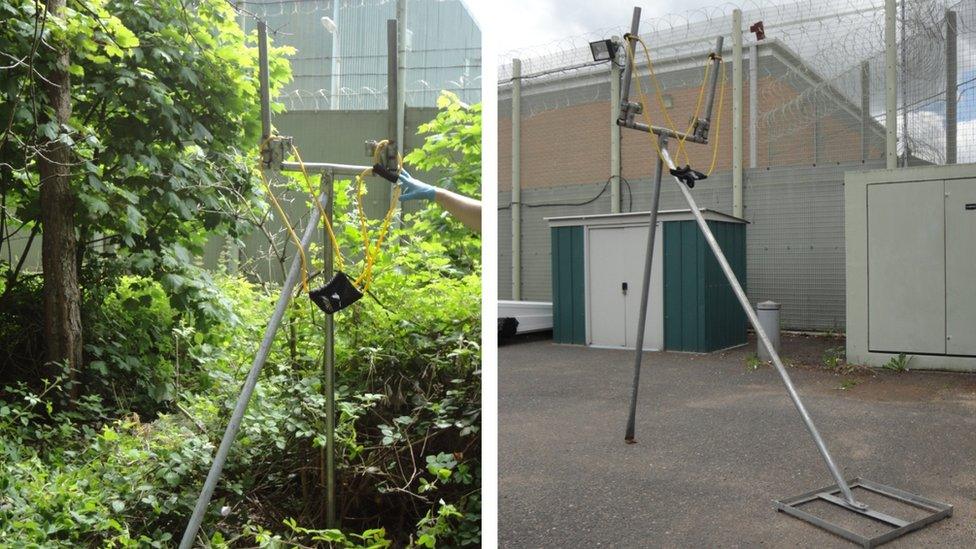Jail 'legal highs' using up local ambulances says watchdog
- Published
- comments

Purpose-built catapult: Used to fire drug packages into a prison
So many prisoners are falling ill from "legal highs" that it is damaging local ambulance services, a watchdog has warned.
Nick Hardwick, chief inspector of prisons, said abuse of psychoactive substances had turned them into the top jail security problem.
Mr Hardwick said emergency calls for prisoners with fits and blackouts had "depleted" local ambulance services.
The Prison Service said it took a "zero tolerance" approach to drugs in prison.

What are New Psychoactive Substances?
Chemically-designed products which mimic drugs that are already banned.
One former inmate explains how the drugs were more addictive than crack
Some 67 deaths in England and Wales linked to their use last year.
Seizures of the key NPS almost doubled between 2013 and 2014, external
Known as "legal highs" but in most cases they are only lawful because there has been no scientific testing and advice leading to a ban.
One hundred new NPS products emerged across the EU last year

While some substances remain technically legal, all forms of synthetic cannabis, often known as spice or mamba, are banned in prisons.
Legislation currently going through Parliament, external will create a blanket ban on all new psychoactive substances (NPS) and their successors.

Packages: Drugs are often hidden in packages and weighted with coins to accurately land them on target
But Mr Hardwick said NPS use was now so rampant that emergency calls to deal with fits and blackouts were leaving local ambulance resources "depleted" - and in at least one jail they were dubbed "mambulances".
One incident at HMP Wealstun, near Wetherby, West Yorkshire, led to all available ambulances being sent because of the number of inmates needing treatment.
"There wasn't the resilience," said Mr Hardwick. "If there had been something happening in the community, they weren't there to deal with that because they were in the prison. It is a big issue."
Sophisticated smuggling operations included occasions when Kinder Surprise chocolate eggs had been used to secrete the drugs inside a carrier's body. Gangs used large catapults to fire packages over jail walls - and the latest technique was package-carrying drones.
Some offenders deliberately breached their release conditions so they could return to jail carrying a new batch of NPS products inside their bodies.

Some 67 deaths in England and Wales last year were linked to the use of new psychoactive substances
Number one threat
Mr Hardwick said the report team's review of evidence from 61 prison inspections plus a survey of nearly 11,000 prisoners led to them conclude that the drugs were now the most serious threat to safety and security.
"The risks involved in supply are low and large profits can be made," he said. "Distribution... may be linked to organised crime."
The report said that they had heard credible accounts of prisons being used as "spice pigs" to test newly arriving batches and debts were being enforced against friends and family.
"We think we need ministers to actually lead a process of keeping patterns of drug use under review and making sure there's an adequate response," said Mr Hardwick.
"Otherwise we think there is a danger that complacency will creep into the system."
A Prison Service spokeswoman said: "We take a zero-tolerance approach to drugs in prison and there are already a range of robust measures in place to detect drugs, including the use of sniffer dogs, searches of cells and mandatory drugs tests.
"We recently introduced tough new laws which will see those who smuggle packages over prison walls, including drugs, face up to two years in prison.
"Those who involve themselves in the distribution of drugs in our prisons should know that they will face prosecution and extra time behind bars."
But Mike Trace of the Rehabilitation for Addicted Prisoners Trust (RAPt) said its staff had charted a seven-fold increase, external in the last year in the number of inmates asking for help to kick the NPS habit.
"The impact is shocking, with violence, addiction and deaths becoming more common," said Mr Trace. "For the first time in 24 years there are times when our staff are even worried for their own safety. There is no one quick fix - but by working with prison security, developing testing and providing rehabilitation treatment services we can tackle this major problem."
- Published9 November 2015

- Published23 October 2015
